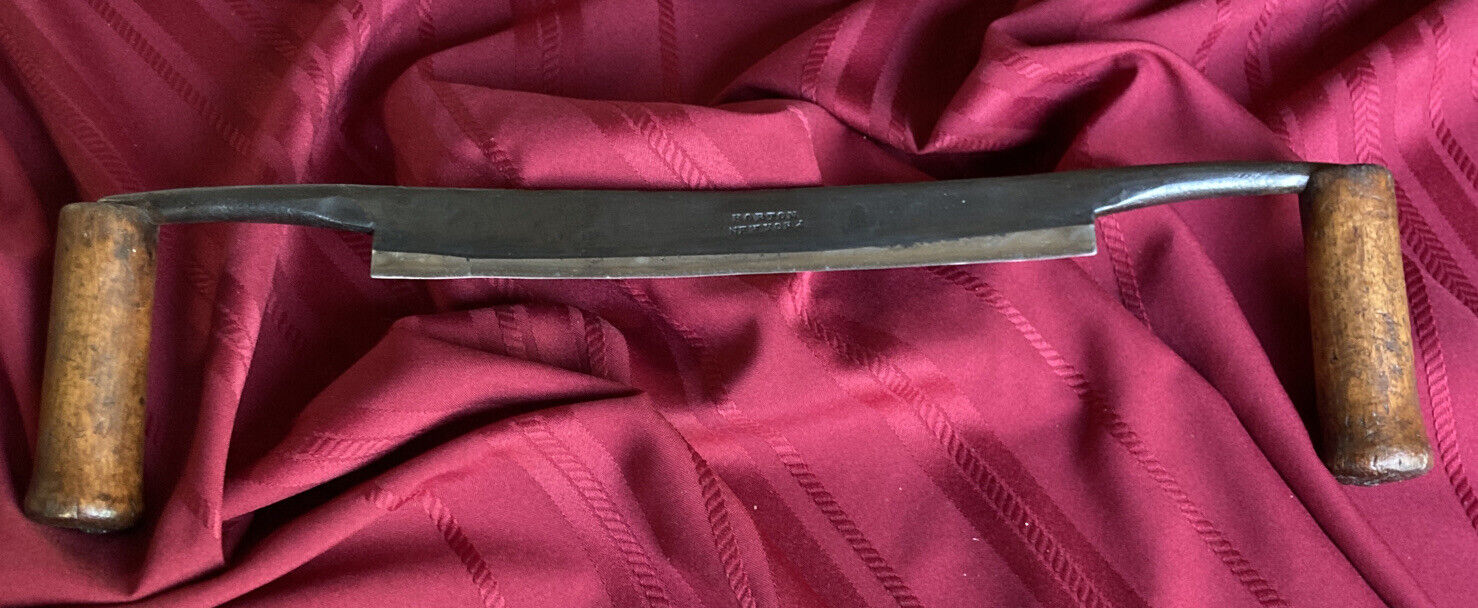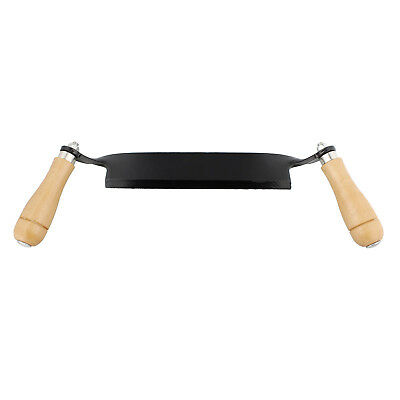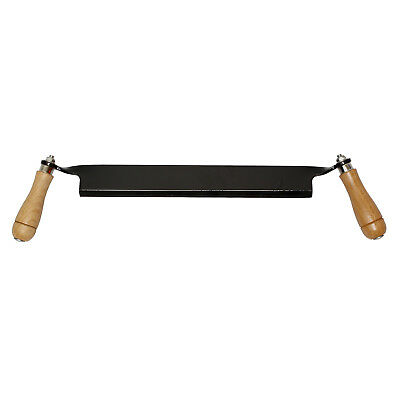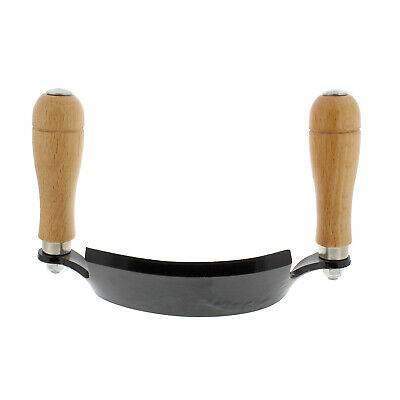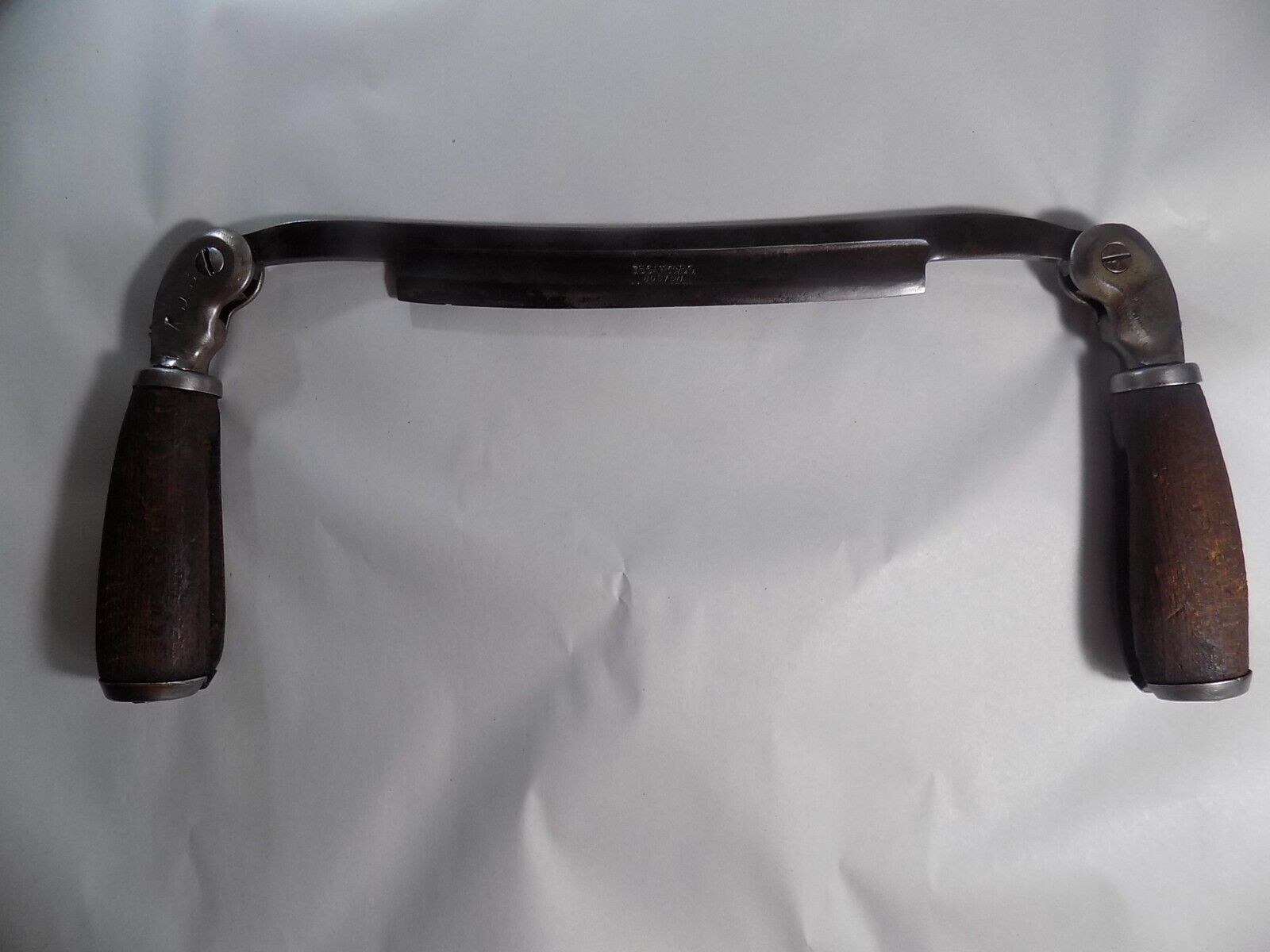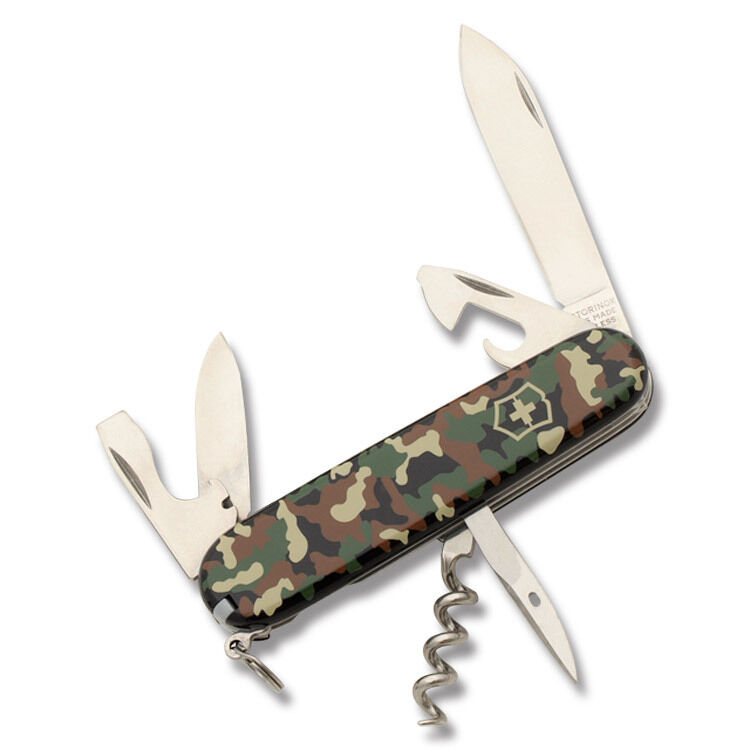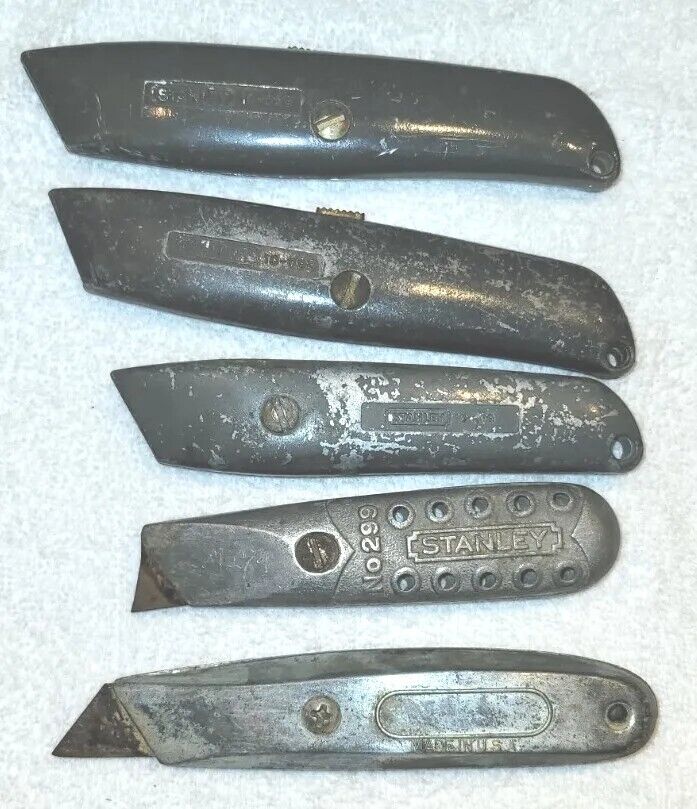-40%
✨HORTON 11" Draw Knife Tool - RESTORED and SHARP(!!) Ready to use! Woodworking
$ 39.59
- Description
- Size Guide
Description
Here we have a very nice HORTON of New York 11" Draw KnifeThis drawknife has been Fully RESTORED and SHARPENED (SCARY SHARP!!! )
This drawknife comes from an extensive collection of antique and vintage hand tools, and it was restored by the Restored Glory Toolworks exclusively for this collection, and has spent much of its latter life as part of this collection. For more information on the Restored Glory Toolworks, see below
The blade was sharpened and honed down to 6,000 grit with the proper ‘plane edge’ on the flat, and ‘knife edge’ on the top. It is ready to use right out of the box.
Equally at home on display as part of your collection, or on the shaving horse in your wood shop.
A fine example of a drawknife from this collectible maker.
Please see all photos as they are part of the description
Please contact me with any questions
Be sure to check out my other auction items. I will be listing MANY more collectible items from this collection in the coming weeks/months, so be sure to check back frequently for more treasures!!
Good luck, and happy bidding!!
***************
A word about tools restored by; Restored Glory Toolworks:
We are woodworkers who, in searching for fine tools for the trade discovered that more often than not, antique/vintage tools were the only acceptable tools for the job at hand. Out of necessity, we began restoring old, ‘rusted ~n~ busted’ tools, mainly for our own use. Over time the word spread and folks were asking us to fix, repair, and restore tools for them.
It is our mission at Restored Glory Toolworks to put fine antique/vintage tools in good working order, into the hands of craftsmen who can then make beautiful things with them. It was never, and is not today, our goal to restore tools for collections and/or museums.
Be that as it may, more than a few of our restored tools have found their way into some prestigious collections. We are flattered.
When we say that our tools are ‘Restored’ it is the rare tool that can be brought to ‘as new’ condition (although we have accomplished that on occasion).
We strive to restore our tools using the methods of the original manufacturer. By this, we mean that if the original tool was painted with a baked-on enamel, that is what we use. If it was painted with a lacquer, that is the treatment that the tool will receive. Many antique tools received an ‘asphaltum Japanning’ finish , and Stanley, Union, and others used this finish extensively (usually pre WWII). This is a costly, laborious, and time consuming process, but this is exactly that which those tools will receive. The process requires coating the tool and alternating between baking cooling (for a period of one hour each) at 50 degree increments starting at 150 degrees all the way through 450 degrees. We then repeat the process for up to two to three coats(!) in short, the process takes several days to achieve the very durable ‘as new’ finish required for these tools.
In other cases, it is either impossible, or simply cost prohibitive to apply a finish the tool at all. In the case of tools coated with nickel plating, this simply cannot be done on a small scale. In these cases, if the tool has at least 30% of the original finish remaining, the finish will be buffed to remove any oxidation, and then coated with a mixture of waxes, and rust inhibitors, and left with it’s original nickel plating. If the finish is missing more than 70% or it’s original finish, the tool will be stripped down and refinished with either a Japan finish, a gun-blued finish, or a painted finish, depending upon the tool. In every case, we will fully disclose the process used.
In the process of any restoration, all parts will be inspected, and any worn, or damaged parts will be replaced, unless said parts cannot be obtained, in which case, such information will be disclosed.
As mentioned, the goal of Restored Glory Toolworks is to put our tools into the hands of those who will apply them to the task/s for which they were created - usually woodworking. To these ends, a tool is only as good as it’s sharp edge. Unlike store bought tools - even premium tools - tools from Restored Glory Toolworks come to you SHARP (!!!) and ready to house right out of the box.
How Restored Glory Toolworks sharpens tools:
Plane blades & chisels:
First, any blades with any surface rust are soaked in a de-rusting solution. Once completed, they are cleaned, and prepared for sharpening. The blades are first flattened to insure a keen flat edge. The blades are then sharpened to 30 degrees for bench planes, 25 degrees for bevel-up block planes, or another angle for custom planes. The sharpening process begins at 80 grit and is sharpened on progressively finer grits (10 different grit sizes in all) finally ending with a buffing ending at 6000 grit. The resultant edge is a mirror finish as sharp as could possibly be attained! Each blade in then placed in it’s plane and test cuts are made to assure the desired results. The blades are then cleaned and a coating of Boshield T-9 is applied to prevent rust. This coating can be removed either by wiping down with mineral spirits / turpentine, or simply using on a piece of scrap wood and having the coating wear off naturally. Our results speak for themselves.
Auger bits.
Auger bits are first inspected for properly formed cutting ‘wings.’ Any bits without ‘wings’ with enough substance to be sharpened, are discarded. At this point, the bits are cleaned and polished, and inspected again. Most bits that have been in the field have some level or another of rust pitting. The bits are inspected to assure that the pitting is cosmetic and will not affect the bit’s ability to hold an edge and/or cut properly.
Bits that have made it this far, are then moved to sharpening.
Most folks simply use an auger file to sharpen auger bits. At Restored Glory Toolworks, this is only the first step. The leading edge is filed back to it’s proper edge, as is the inside leading edge of the cutting ‘wings.’ At this point, the bits’ edges are honed to a razor sharpness using a series of diamond hones. The resultant edge is simply the sharpest auger bit that you have used, or will ever will use. Each bit is then individually chucked into an auger brace and tested for speed of cut. Any bit that fails the test is put back through the sharpening process. A bit is useless unless in can cut cleanly, and cut FAST. And Restored Glory Toolworks auger bits cut CLEAN, and cut FAST! All bits are then coated with Boshield T-9 to resist rust.
Saws:
Modern saws found in big box stores are made from hardened steel and made to be disposable (non Sharpenable). A hardened steel blade holds its edge longer. While this is convenient, anyone who has used an antique Diston or Atkins (or other well made antique) saw and compared it to a big box ‘throw-away’ saw, knows why master craftsmen buy antique/vintage saws, or high quality (and expensive) saws from the likes of Lie Nielsen, Bad Ax tools, or Florp tools.
All antique/vintage handsaws that come to Restored Glory Toolworks are first checked for the integrity of the blade. A kinked, bent, or otherwise compromised blade usually renders the saw worthless as a tool. Some blades can be restored, but they usually need a lot of work, and more importantly, machinery beyond our scope of work. Such compromised blades are either donated to artists to be painted upon and made into art, sent to a specialists metalworker to restore the integrity of the blade, or simply trashed.
If a saw has made it this far, the handle and teeth are inspected. While a sheared horn on a handle will devalue the monetary value of the saw, as long as there is a good solid connection between the handle and the blade, we will most often work with the handle that came with the saw. If the handle is mangled, we will replace it, most often with a handle from the same manufacturer and for the same model. If this is not an option, we will replace it with a custom handle.
We then look at the plate of the saw. Because most saws were produced to be left ‘in the white’, meaning that the manufacturer did not put any finish on the saw (this is because in using the saw, cutting through wood will wear down any finish anyway), most saws were simply wiped with a rust preventative coating, which is wiped off, or worn off with use. As such, MOST saws have some level of surface rust and/or pitting. Presuming that the saw’s level of corrosion was only cosmetic and made it this far in the process, the saw’s ‘plate’ or blade will be soaked in a rust removing solution, then cleaned and buffed out and ready for setting and sharpening.
At this point it is onto the teeth of the saw. Roughly 60% of the saws that we receive can be restored by simply resetting and sharpening the teeth. The remaining 40% need to have the teeth completely recut.
If the teeth need to be recut, we will grind the teeth flat and level, and start anew. The teeth are then re-cut into the blade before setting and sharpening. if the teeth do not need to be completely recut, most saws still need to have the teeth leveled (jointed) to assure that all of the teeth are level and even. Once jointed, the teeth are ground to make them all equal and even with one another (except in the case of specialized saws where the teeth pattern changes along the length of the saw).
Many people will sharpen the teeth before ‘setting’ them. This process can be faster, but we believe that because setting the teeth changes ever so slightly the forward angle of the teeth, and thus changing the ‘rake’, that it is important to first ‘set’ the teeth, and only then do the actual sharpening.
We sharpen all of our saws one tooth at a time - BY HAND. Through the years there have been multiple machines devised for sharpening saw teeth, but through experience, we believe that the only way to get a razor sharp tooth on a saw (like that of an auger bit above), is to do so by hand. It takes longer, but we believe that the results speak for themselves, and perfection is rarely a fast and easy process.
Our saws are then put to the test. Each saw is at this point used to make test cuts based upon the tooth configuration (rip or cross cut), to confirm that it cuts as well, or better than when it was new. The saw is then cleaned and coated with Boshield T-9 to prevent rust. To remove the coating, use mineral spirits- or simply use the saw on a piece of wood to wear it off naturally.
Restored Glory Toolworks will place any of our saws against a premium hand saw (many multiples of price HIGHER than a restored antique/vintage saw). A new premium saw may look better not having the cosmetic pitting found on antique/vintage saws, but a finely restored and properly sharpened quality antique handsaw will cut as cleanly and as quickly as a new premium saw. And besides, we kind of like the ‘character’ that comes with an antique/vintage saw. So if you want a saw that cuts true, cuts clean, and cuts FAST, buy a Restored Glory Toolworks hand saw - or buy a new premium saw. But regardless, once you have used a hand sharpened saw, be it our restored saws, or a premium high-end saw, you’ll never buy a big box store saw again.
As mentioned, we at Restored Glory Toolworks are woodworkers. We restore tools the way that WE WANT THEM, and we are proud to now share these fine tools with you.
(Note on Boshield T-9: Restored Glory Toolworks has no affiliation with Boshield. We received no compensation for its use, and we buy it at full retail price. We have tried many different coatings for our tools and found that it strikes an acceptable balance between rust protection, and lack of discoloration. With this said, there is still a certain level of discoloration when used on metal - especially on iron (of which MANY of these tools are made). But while we would like zero discoloration, prohibiting rust and maintaining the integrity of the tool is our primary concern. As such, one should expect some slight discoloration to any bare metal on the treated tools)
Enjoy.
